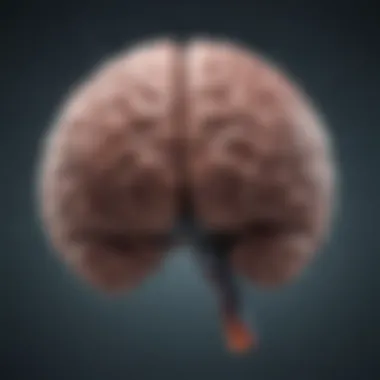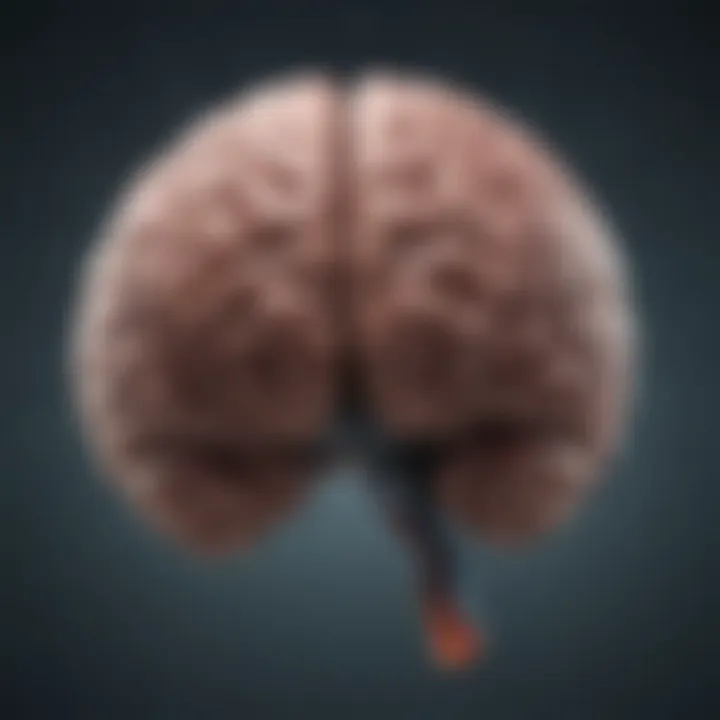Exploring the Depths of Sadness: A Comprehensive Guide


Research Overview
Prelude to the Topic
Sadness is a universal feeling yet often remains poorly understood. It can ebb and flow, influenced by many factors, both seen and unseen. Different cultures perceive sadness through various lenses, revealing a tapestry of human experience. The reasons behind its occurrence can range from personal loss to broader existential reflections. Understanding sadness is crucial as it provides insights into human behavior, emotional processing, and even our social dynamics.
Summary of Existing Research Findings
Research into sadness spans several disciplines, including psychology, neuroscience, and sociology. Many studies have highlighted how sadness plays a roles in developing resilience and empathy. For instance, findings demonstrate that those who experience sadness are more likely to connect deeply with others facing similar challenges. Moreover, biological studies show the role of neurotransmitters like serotonin and dopamine in regulating mood and emotional states. This interplay between psychological and biological factors sets the groundwork for a richer understanding of sadness.
Key Research Methodology Explained
Most of the literature on sadness employs various research methodologies, from qualitative interviews to quantitative surveys. Notably, longitudinal studies, which follow subjects over time, reveal patterns in how sadness develops and recedes. Additionally, experimental approaches often involve measuring physiological responses to emotionally charged stimuli. By combining these methods, researchers can draw a comprehensive picture of how sadness impacts individuals within their distinct environments.
Health Implications
Discussion on the Impact of the Research on Health
Research findings shed light on various health implications tied to sadness. Chronic sadness can lead to significant mental health issues, such as depression and anxiety, particularly when not addressed. Recognizing the signs of sadness early can lead to timely interventions, potentially reducing the risk of more severe mental health complications.
Exploration of Potential Benefits and Risks
While sadness is often perceived negatively, it can have beneficial aspects. For instance, occasional sadness can promote self-reflection and foster connections with others. However, prolonged sadness poses risks. It may lead to withdrawal from social activities or develop unhealthy coping mechanisms, such as substance abuse. Understanding the dual aspects of sadness can help individuals navigate their emotional landscapes more effectively.
Examples of How the Findings Can Be Applied in Daily Life
Recognizing the signs of sadness can empower individuals to adopt healthier lifestyles. Simple practices, such as journaling or seeking the support of friends, can work wonders. Engaging in community activities or seeking professional help, if necessary, can also be beneficial. Integrating these strategies fosters a proactive approach to managing sadness.
Well-being Strategies
Practical Tips and Strategies Derived from the Research
- Mindfulness Practices: Engage in activities like meditation or yoga. These practices can help in creating a sense of calm, aiding emotional regulation.
- Social Connections: Maintain close ties with family and friends. Strengthening these relationships serves as a buffer against feelings of sadness.
- Physical Activity: Regular exercise is not just beneficial for physical health but is also linked to improved mood levels. A simple walk outdoors can elevate your spirits.
Advice on Implementing Positive Changes for Well-being
Incorporate small changes to your routine, such as designating time for hobbies or interests. Also, try to establish a regular sleep schedule. Ensuring that you get quality rest can dramatically influence overall mood.
Personal Stories or Case Studies Supporting the Strategies
Many individuals recount how consistent journaling helped them process feelings of sadness. One story highlights a person who, after losing a loved one, found solace in writing letters to them, ultimately granting a sense of closure and healing. Such anecdotes provide compelling evidence for practical strategies.
Expert Insights
Analysis of Expert Opinions on the Research Findings
Experts emphasize how acknowledging sadness plays a significant role in mental health. They argue that society often stigmatizes the emotion, which can exacerbate feelings of isolation. Instead, many advocate for a more open dialogue about feelings of sadness to destigmatize this natural human experience.
Q&A Session with a Relevant Expert on the Topic
Q: What is the primary misconception people have about sadness? A: Many people consider sadness as a purely negative feeling. However, it serves essential functions in our emotional repertoire, allowing us to process loss and create deeper connections.
Links to Related Articles or Studies for Further Reading
Recommended Books, Websites, or Courses for In-depth Learning
- "The Anatomy of Sadness" by Dr. Jane Smith
- Online course: "Emotional Intelligence and Mental Health"
Tools or Apps That Can Assist in Applying the Research Findings
- Moodfit - a mental health app that helps track emotions
- Happify - offers activities and games to enhance emotional well-being
Research opens doors to understanding sadness as a complex emotional state, urging readers to recognize its importance instead of merely viewing it as a burden.
Defining Sadness
Understanding sadness isn't just a matter of checking a box on an emotional checklist; it's a fundamental step in grasping how we experience and handle our feelings. This section sets the stage for exploring sadness in various contexts, bringing to light the nuances and layers inherent in this emotion. Being equipped with a clear definition helps individuals recognize their own experiences of sadness and relate to others in a more compassionate manner.
Emotional Landscape
Sadness resides within an expansive emotional landscape. It can manifest as a fleeting mood, a deeper emotional state, or something that even feels unshakeable over time. To properly navigate through it, one must appreciate the factors that contribute to the experience of sadness. For example, consider how a person might feel when they lose a job. Initially, there might be a tense mix of anger and disbelief; however, as time passes, that could shift into a profound sense of sadness rooted in loss and uncertainty. Such a transformation illustrates how emotions are fluid and interconnected—a kind of emotional ebb and flow.
Some essential elements of the emotional landscape include:


- Triggers: Events or circumstances that activate feelings of sadness.
- Intensity: The depth of sadness can vary significantly among individuals.
- Duration: While some may experience transient sadness, for others it can develop into a more chronic state.
By acknowledging these components, individuals can better understand their emotional responses. Through learning about personal experiences, they can diagnose the roots more effectively and seek appropriate paths to relief.
Historical Perspectives
Examining sadness through the lens of history reveals the shifting attitudes societies have held toward this complex emotion. Civilizations throughout the ages have painted varied portraits of sadness, often tethered to cultural beliefs and practices. In ancient philosophies, such as Stoicism and Buddhism, sadness was regarded not merely as an emotional nuisance but as an integral aspect of the human condition that called for introspection.
Interestingly, literature has long served as a mirror for society's relationship with sadness. From the melancholic verses of John Keats, contemplating the transient beauty of life, to the raw portrayals of despair in Virginia Woolf's characters, literature captures collective sentiments, influencing perceptions of sadness.
Here are some significant historical points to consider:
- Classical Views: In antiquity, philosophers like Aristotle contemplated sadness as part of the human psyche, linking it to virtue and morality.
- Romantic Era: This period romanticized melancholy, suggesting that it could inspire creativity and depth in relationships and art.
- Modern Perspectives: Nowadays, the medical model often emphasizes biochemical causes of sadness, yet it’s crucial to continue exploring its meaning in human connections.
By untangling these historical threads, the complexities of sadness become clearer, offering contemporary individuals valuable insights for their own emotional journeys. Understanding sadness's history can dispel the stigma surrounding it, encouraging a more compassionate discourse about mental health in today’s society.
Psychological Frameworks
Understanding sadness through psychological frameworks provides a structured way to unravel the layers behind this complex emotion. These frameworks not only elucidate how people experience sadness but also highlight the various factors influencing it. They emphasize the significance of emotional responses in an individual’s mental health journey. By exploring theories of emotion and the role of sadness in mental health, we can develop a nuanced perspective that brings clarity to our emotional landscapes.
Theories of Emotion
Emotions are multi-dimensional; they are shaped by biological, social, and cultural contexts. A foundational theory of emotion is the James-Lange Theory, which posits that physiological changes occur first, and these changes are then interpreted as emotions. For instance, feeling sadness might follow a physical sensation, such as heaviness in the chest or tears streaming down one’s face. Another notable framework is the Cannon-Bard Theory, which suggests that emotions and physiological reactions happen concurrently. This notion hints at the complexity behind sadness—it isn't simply about feeling low; it's about how our bodies react and respond, intertwining the emotional with the physical.
Further, Schachter-Singer’s Two-Factor Theory adds layers by introducing cognitive appraisal. This perspective emphasizes that our interpretation of arousal and context gives rise to the feeling of sadness. In other words, sadness is not just a reaction but involves interpreting various stimuli and our internal state. Knowing these theories helps one comprehend why sadness can vary widely among individuals. Some might feel sadness deeply after a loss, while others may exhibit it in subtle ways, highlighting the variability in emotional responses.
Sadness in Mental Health
Mental health discussions increasingly recognize that sadness, while often viewed negatively, can play a crucial role in our psychological landscape. Understanding clinical perspectives allows for a more compassionate approach to those experiencing persistent sadness.
Clinical Perspectives
When examining clinical perspectives, one cannot overlook the distinction between normal sadness and clinical depression. Clinical perspectives hinge upon established diagnostic criteria that inform treatment. Sadness may shift from a transient feeling into something more chronic, such as Major Depressive Disorder. In such cases, sadness is often accompanied by a host of other symptoms, including sleep disturbances and difficulty concentrating.
One characteristic of clinical perspectives is their reliance on standardized assessments. These assessments can provide insight into the severity and duration of emotional states, assisting professionals in making informed decisions regarding intervention strategies. Additionally, this approach is beneficial because it not only identifies symptoms but also contextualizes them within the individual’s overall mental health journey.
Unique as it may be, a potential disadvantage of such clinical perspectives can be the over-reliance on labels. When individuals are diagnosed, they may inadvertently identify as their condition rather than as a complex series of experiences—all of which can complicate recovery.
Common Disorders Associated with Sadness
Sadness isn’t a standalone emotion; it often intertwines with various psychological disorders. Conditions like Persistent Depressive Disorder (Dysthymia) and Seasonal Affective Disorder showcase how sadness can manifest as part of broader psychological issues. Recognizing these common disorders aids in understanding that sadness is sometimes not just a symptom but a central feature that impacts quality of life.
The key characteristic of common disorders associated with sadness is their ability to disrupt daily functioning. Unlike fleeting sadness, these disorders can impair relationships, work productivity, and overall well-being. They are significant in this article because they remind readers that prolonged sadness is not merely an emotional hurdle; it can lead to chronic consequences if unaddressed.
A unique feature of understanding these disorders is the recognition of overlapping symptoms—changes in appetite, energy levels, and feelings of worthlessness. This overlap highlights the intricate tapestry of mental health where sadness doesn't emerge in isolation but rather as part of a complex interplay of experiences and symptoms. Despite the insights provided, it’s essential to approach these discussions with the understanding that while disorders may often have clinical labels, individual experiences of sadness can vary widely.
"Understanding the frameworks behind sadness can illuminate paths toward healing, bridging gaps between emotional experiences and psychological theories."
In summary, comprehending psychological frameworks surrounding sadness can equip individuals with the knowledge necessary for self-awareness and emotional regulation. The interplay of theories of emotion and mental health elements elucidates the intricate relationships between sadness, personal experiences, and broader psychological constructs. This understanding lays the groundwork for effective coping mechanisms and therapeutic interventions, ultimately getting us closer to navigating sadness in the human experience.
Biological Underpinnings
Understanding the biological underpinnings of sadness is crucial in grasping how this emotion manifests in the human experience. Sadness is not solely a psychological state; it is intimately connected with our biology. The interplay of neurochemicals and genetic elements shapes the way individuals experience, express, and manage sadness. By delving into these foundations, we can better appreciate the complexities of this profound emotion.
Neurochemical Factors
Neurochemicals play a pivotal role in regulating mood and emotional response. Three key neurotransmitters often associated with sadness include serotonin, norepinephrine, and dopamine. Serotonin, for instance, is frequently dubbed the 'feel-good hormone' because it contributes to feelings of well-being. A deficit in serotonin levels can lead to increased feelings of sadness, contributing to conditions such as depression.
- Dopamine is another crucial factor; associated with the pleasure-reward circuit in the brain, low levels can result in diminished motivation and a lack of enjoyment, amplifying feelings of sadness.
- Norepinephrine, on the other hand, is involved in arousal and alertness. An imbalance in these neurochemicals can create a storm of emotional turmoil, leading to states of chronic sadness.
Researchers are continuously exploring how these neurochemical interactions inform our understanding of sadness. For instance:
"Changes in neurotransmitter levels can transform a person’s emotional landscape, highlighting the biological weight of feelings.”
Genetic Influences
Genetics further complicates our understanding of sadness. Studies have suggested that certain individuals may have a genetic predisposition to experience sadness more intensely or frequently than others. Specific genes, such as those involved in serotonergic functioning, are linked to mood disorders and variations in emotional response.
- The 5-HTTLPR gene variant, for instance, has been shown to affect serotonin transporters and has been associated with increased vulnerability to depression in individuals facing stressful life events.
- Additionally, family history can shed light on the likelihood of experiencing prolonged or intensified sadness, suggesting that emotional responses can be inherited.
Recognizing these genetic contributors is vital as it helps demystify why some individuals may find themselves in a persistent cycle of sadness. Understanding that there are real biological factors at play can enable a more compassionate perspective on those grappling with their emotional states.
In summary, the biological underpinnings of sadness reveal a complex tapestry woven from neurochemical interactions and genetic influences. Recognizing these elements is not just academic; it shapes the way we can approach emotional well-being in ourselves and in those around us.
Environmental Contributors


Understanding sadness goes beyond individual emotions; it's crucial to view it through the lens of environmental influences. These external factors shape our experiences and add complexity to the emotional landscape. Life events, cultural context, and stressors all contribute in various ways. Recognizing these influences can illuminate why certain emotions arise and how they evolve over time.
Life Events and Stressors
Life events are a major player in the onset of sadness. These significant incidents can range from joyful occasions that take an unexpected turn to the gut-wrenching moments characterized by loss or hardship. Events such as divorce, job loss, or the death of a loved one create emotional ripples that can be felt for months, if not years. So, why does this happen?
- Change in Routine: Major life changes disrupt our daily patterns. When the familiar vanishes, it can lead individuals to feel lost or adrift, contributing to feelings of sadness.
- Unresolved Grief: Loss is inherently complex. Grieving doesn’t follow rules; it can linger and affect people differently based on previous experiences, relationships, or coping mechanisms.
- Accumulation of Stress: Sometimes, stressors stack up like dishes in a sink. A barrage of small issues like relationship quarrels or financial worries can compound, resulting in a feeling of hopelessness, draining one’s emotional energy.
"Sadness can often be a signal from our environment, reflecting our struggles and pushing us to adapt."
Cultural Context
Cultural background certainly colors how we experience and express sadness. Different cultures designate unique meanings to sadness, affecting how one copes with it.
- Stigma and Acceptance: Some cultures encourage openness about emotions, while others prefer to maintain a stoic facade. This cultural dichotomy can heavily influence someone’s willingness to confront or acknowledge their feelings.
- Social norms around grief vary greatly and determine the rituals that follow a loss. For instance, in certain communities, extended mourning periods are mandated, while others promote moving on quickly.
- Collectivism vs. Individualism: In collectivist cultures, community plays a critical role in emotional support. An individual may find solace in their family or community, while individualistic societies may leave people more isolated.
Navigating the cultural labyrinth around sadness offers profound insights into the emotional suffering shared across humanity. Understanding these varied narratives helps to build empathy and context, highlighting that sadness, though deeply personal, often finds its roots in the collective experience.
Common Causes of Sadness
Understanding the common causes of sadness is vital for recognizing and addressing this emotion in our daily lives. Sadness, while a natural part of the human experience, often arises from specific triggers or circumstances that can profoundly affect an individual’s mental and emotional well-being. By gaining insight into these causes, one can better navigate their feelings and seek appropriate support or coping strategies.
Loss and Grief
Loss is one of the most significant contributors to sadness. Whether it is the death of a loved one, the end of a relationship, or even the loss of a job, these experiences can leave a person feeling overwhelmingly despondent. Grief, while a natural response to loss, can take many forms.
- Stages of Grief: According to the Kübler-Ross model, these stages—denial, anger, bargaining, depression, and acceptance—represent the emotional journey many go through. It's crucial to understand that everyone experiences these stages differently. For some, they may unfold in order; for others, it might be a more chaotic experience.
- Impact on Daily Life: Sadness linked to loss can hinder daily activities and affect physical health. It’s not uncommon for individuals recovering from loss to feel fatigued or withdrawn.
In moments of loss, it is beneficial to acknowledge the pain rather than suppress it. Reaching out for support—be it from friends, family, or professionals—can help one navigate this challenging emotional landscape.
Loneliness and Isolation
Loneliness often creeps in quietly, yet it has a profound impact on one’s emotional health. It’s not solely about being physically alone; feeling disconnected from others can cultivate deep sadness.
- Social Connections: Our relationships play a significant role in our emotional well-being. When connections wane, whether through moves, life changes, or even social media dynamics, a person can feel isolated. This disconnection might trigger feelings of sadness, stemming from a belief that one is not valued or understood.
- Changing Environments: A move to a new city or even changing jobs can contribute to feelings of isolation. Suddenly, familiar faces and supportive networks are miles away, leaving a void that can be hard to fill.
It's imperative to be proactive about combating loneliness. Engaging in community events or reaching out to old friends can rekindle connections and foster a sense of belonging.
Unrealized Expectations
Expectations, while a natural aspect of life, can be a double-edged sword. When one’s hopes—be it in career, personal growth, or relationships—go unfulfilled, disappointment often manifests as sadness.
- Setting Realistic Goals: It is important to set realizable expectations. Unrealistic goals often lead to feelings of failure, which can deepen sadness. The more one feels that their aspirations are out of reach, the more disheartened they may become.
- Comparison with Others: In today's age of social media, it's easy to fall into the trap of comparing one’s journey with others'. This comparison can intensify feelings of inadequacy when one believes they should be further along in life.
Recognizing and reassessing our expectations can be valuable. By adapting goals to be more achievable, individuals can foster a sense of accomplishment and mitigate feelings of sadness rooted in disappointment.
"Understanding the roots of sadness is akin to navigating a maze. Once you identify paths that lead to emotional pain, you’re better equipped to find your way out."
In exploring these common causes of sadness, we gain not only insights into our emotional responses but also tools to address them actively. This awareness can foster healing and facilitate personal growth.
The Role of Sadness in Human Experience
Sadness, a fundamental aspect of our emotional spectrum, plays a significant role in shaping the human experience. This section unpacks why sadness matters, not just as a fleeting feeling, but as a vital part of emotional and psychological growth. Though often seen in a negative light, understanding and embracing sadness can ultimately enrich our lives. By capturing the essence of sorrow, we can appreciate moments of joy more deeply and approach life's vicissitudes with a more resilient mindset.
Emotional Regulation
Sadness serves as a powerful tool in emotional regulation. When we experience this feeling, it can act as a signal, alerting us to the need for introspection and adjustment in our lives. Unlike the more commonly touted emotions like joy or excitement, sadness invites stillness and contemplation. The slower pace allows for critical self-examination, helping us to process our thoughts and feelings more effectively. In fact, grieving a setback or reflecting on unfulfilled expectations can help us sort through the noise and recognize what truly matters.
When we experience sadness, our brain activates different pathways associated with reflecting on our circumstances. This introspective process can lead to positive behavioral shifts, ultimately facilitating growth. Additionally, it reminds us of our vulnerabilities, fostering empathy not just towards ourselves, but also others in similar situations. Thus, sadness often acts as a catalyst for deeper connections in our social lives, pulling us close to those who experience similar emotional waves.
Catalyst for Change
Moreover, sadness can serve as a catalyst for change. The discomfort associated with this emotional state often pushes individuals to seek new strategies or perspectives in life. Think about it: hitting rock bottom often galvanizes people to make significant life changes. The desire to escape the weight of sadness frequently leads to profound transformations. Whether it’s embarking on a new career path, pursuing neglected passions, or simply reevaluating relationships, sadness compels us to confront our realities.
This urge to change sits at the core of human evolution. As we navigate through sadness, we can discover renewed motivation, often redirecting our energies into more fulfilling endeavors. Many great works of art, literature, and philosophy have emerged from the melancholic musings of their creators, transforming pain into something beautiful and thought-provoking.
"Sadness has a way of renewing our spirits and reinforcing the bonds we share with others."
Coping Mechanisms
Coping mechanisms play a crucial role in navigating the intricate landscapes of sadness. Understanding how to effectively manage feelings of sadness can greatly enhance emotional well-being. These mechanisms can vary widely among individuals; what works for one person might not work for another. By exploring various strategies, people can discover tools that resonate with them and serve to lighten the emotional load.
The benefits of well-structured coping strategies include promoting resilience, decreasing anxiety, and fostering emotional flexibility. They help individuals not only cope with negative emotions but also cultivate skills for dealing with future challenges. Importantly, it’s not merely about reducing feelings of sadness; it's about embracing the full spectrum of human emotions in a balanced manner.
Meditation and Mindfulness


Meditation and mindfulness stand as powerful allies in the fight against sadness. These practices encourage individuals to become acquainted with their own thoughts and feelings without judgment. By cultivating awareness, one can develop a more nuanced perspective on conflicting emotions, potentially revealing underlying causes of sadness.
In daily practice, mindfulness invites individuals to engage with the present moment. Simple techniques like deep breathing or body-scanning can dissolve the overwhelming grip of sadness. They allow a nature of acceptance that has profound therapeutic effects. For many, establishing a consistent meditation routine not only fosters inner peace but also builds emotional resilience over time.
Therapeutic Approaches
Cognitive Behavioral Therapy
Cognitive Behavioral Therapy (CBT) stands out due to its ability to reshape thought processes associated with sadness. A core aspect of this therapeutic approach is the focus on identifying negative thought patterns that lead to emotional distress. By restructuring these thoughts, individuals can alter their emotional responses and behaviors.
The key characteristic of CBT is its structured nature, which provides a clear roadmap for both therapists and clients. This framework is especially appealing to those seeking tangible results. It’s a beneficial choice as it often leads to visible improvements in mood and overall emotional health in a relatively short period.
A unique feature of CBT lies in its focus on actionable strategies; it equips individuals with practical tools to manage their feelings outside of therapy sessions. While it may require effort and commitment, the advantages often outweigh the challenges, making it a widely preferred option in addressing sadness.
Interpersonal Therapy
Interpersonal Therapy (IPT) emphasizes the social context of emotional distress, particularly how relationships impact feelings of sadness. This approach is structured to improve communication skills and strengthen interpersonal relationships, thereby alleviating some of the pressures that contribute to sadness.
One of the key characteristics of IPT is its focus on the present, rather than digging into past experiences excessively. This direct approach can be comforting for those who fear becoming overwhelmed by past traumas. IPT is often considered advantageous in its relational emphasis, providing a space for clients to explore the connections between their feelings and interpersonal dynamics.
The unique feature of IPT is its emphasis on role-playing and developing new skills to better handle relationships, which can be incredibly helpful. However, it might not suit everyone; some may feel apprehensive about addressing personal relationships head-on. Despite that, its systematic approach to addressing sadness through social lenses is noted for its effectiveness.
"Coping mechanisms not only reduce the burden of sadness but also pave the way for emotional growth."
Overall, integrating meditation, mindfulness, and various therapeutic approaches offers a holistic toolkit for navigating sadness. By employing these strategies, individuals can forge a path toward emotional health that invites understanding rather than avoidance.
Seeking Help
Seeking help for sadness is, at times, a difficult step to take but can be integral for those struggling with overwhelming emotions. Understanding when and how to seek assistance can provide not only relief but also a pathway to deeper self-awareness and healing. When sadness lingers longer than one might expect or interferes with daily life, reaching out for help becomes a crucial consideration.
When to Pursue Professional Assistance
It’s vital to recognize that sadness is a common emotional response, yet there are moments when it may spiral into something more concerning. Here are some key indicators that it might be time to seek professional help:
- Persistent Feelings: If feelings of sadness last for weeks or months rather than just days, it might be time to consult a professional.
- Impact on Daily Life: When sadness starts interfering with work, social interactions, or self-care routines, it's a sign that help is needed.
- Physical Symptoms: Sometimes, emotional distress manifests physically, such as through fatigue, changes in appetite, or unexplained aches. If you notice these, it’s worthwhile to talk to someone.
- Thoughts of Self-Harm: If sadness is accompanied by thoughts of self-harm or suicide, immediate action is essential. This is a critical sign that professional help cannot be put off any longer.
- Loss of Interest: If activities once enjoyed no longer bring joy, it's a clear indicator that all is not well. This shift should motivate one to seek help.
Recognizing these signs isn't a weakness; rather, it’s a courageous acknowledgment of one's need for support. As the adage goes, "A problem shared is a problem halved." By reaching out, individuals take the first step toward understanding their emotions more clearly.
Types of Professionals Available
Finding the right kind of support can often feel daunting. Luckily, there’s a full range of professionals who specialize in helping those grappling with sadness. Here’s a breakdown of different types of mental health professionals who can provide assistance:
- Psychiatrists: Medical doctors who specialize in mental health. They can diagnose conditions, prescribe medication, and offer therapy. A key focus is to address the biological underpinnings of emotional distress.
- Psychologists: These professionals often hold a PhD or PsyD in psychology. They provide therapy, such as cognitive behavioral therapy or psychodynamic therapy, and often work alongside psychiatrists for comprehensive care.
- Licensed Counselors: These practitioners are often trained in specific therapeutic techniques, focusing on guiding clients through their feelings of sadness and helping them develop coping strategies.
- Social Workers: Clinical social workers offer therapy services and can assist with connecting individuals to community resources, which may be critical for holistic healing.
- Life Coaches: While not licensed therapists, life coaches can help individuals navigate through their feelings and provide practical tools for managing sadness in everyday life. They focus on goal-setting and personal development.
Making a decision to pursue help is a significant first step towards feeling better. Choose someone you resonate with and who understands your unique experiences. This choice can transform one’s approach toward sadness, making it easier to manage and understand over time.
Long-Term Implications of Chronic Sadness
Chronic sadness is not merely the occasional melancholic feeling; it's a persistent state that seeps into the fabric of daily life, casting a shadow on physical, emotional, and social well-being. Understanding this topic is crucial because the implications of prolonged sadness can lead to a downward spiral that affects various aspects of life, often requiring a multifaceted approach for intervention and recovery. People need to recognize the signs early, considering both the emotional toll and the long-term consequences that may stem from ignoring this condition.
Impact on Physical Health
The connection between emotional health and physical well-being is not just psychological; it runs deep into biological systems. Chronic sadness can take a toll on multiple bodily functions, leading to real health issues. Individuals experiencing ongoing sadness may find that their immune systems weaken, making them more susceptible to illnesses. The stress hormone cortisol, often elevated in such emotional states, can contribute to various health problems, including:
- Cardiovascular Diseases: Prolonged sadness can lead to increased heart rate and higher blood pressure, thus elevating the risks for heart conditions.
- Gastrointestinal Issues: Anxiety and sadness may also lead to digestive problems like irritable bowel syndrome, causing discomfort that further impacts mental health.
- Chronic Pain: There’s a notable link between sadness and the perception of pain. A sad emotional state can amplify feelings of discomfort, leading to chronic pain syndromes.
- Sleep Disorders: Persistent sadness often disturbs sleep patterns, resulting in insomnia or disrupted sleep. This, in turn, can become a vicious circle; lack of restorative sleep worsens emotional states.
"Chronic sadness is like a thief in the night, stealing not just moments of joy but also the essence of health itself."
Social Relationships
Chronic sadness impacts social connections significantly. As feelings of discouragement linger, people may withdraw from social situations, creating a cycle of loneliness. Relationships suffer, often leading to:
- Isolation: Individuals may avoid friends and family, making it harder to seek support when they need it the most. This isolation can deepen feelings of sadness and hopelessness.
- Communication Breakdown: Experiencing sadness can impair emotional expression. Misunderstanding and difficult conversations can become more frequent, straining relationships with loved ones.
- Support Network Collapse: Friends and family may not know how to respond to consistent sadness. This can lead to frustration on both sides—family members wanting to help but feeling powerless, and the individual feeling more alone than ever.
- Diminished Empathy: Chronic sadness can close off emotional availability. When a person is in a prolonged state of sadness, they may find it challenging to empathize with others, further alienating them from potential support networks.
Closure
The journey through understanding sadness takes us to an intricately woven landscape of emotions, where reflections and anticipations play key roles. It’s not just about grappling with the feeling itself; it’s about recognizing its depth and influence in our lives. Acknowledging sadness allows for a deeper comprehension of the human experience, revealing the facets of resilience and vulnerability that often lie under the surface.
Reflections on Sadness
Sadness is not merely a response to unfavorable events but a fundamental aspect of emotional experience. Reflecting on sadness can yield significant insights into our individual psyches and collective behaviors. It acts as a mirror, showing us what truly matters, invoking thoughts of connection, loss, nostalgia, and sometimes even joy intermingled with grief. In this sense, sadness encourages self-exploration, providing an opportunity to unearth lessons buried beneath emotional pain.
"In the end, we realize that sadness is not a solitary experience; it’s interwoven with the joy of living."
To reflect effectively, one might consider keeping a journal. Writing about moments of sadness can potentially uncover patterns, triggers, or connections to broader life experiences. This reflective practice may lead to greater emotional insight, encouraging individuals to see sadness as part of their story rather than a flaw in their character.
Looking Ahead
What comes after recognizing and reflecting on sadness? There’s an intrinsic hope that lies within acknowledging this emotion. Looking ahead, it’s vital to embrace a mindset that views sadness as transient; it’s a chapter, not the entire narrative. As we navigate through life’s complexities, strategies for coping can become guiding lights, leading us toward emotional balance.
As we look to the future, cultivating resilience and seeking supportive connections can become essential tools. This proactive approach not only fosters healing but also lays the groundwork for personal growth. We ought to shape our interactions with sadness, transforming it from a stumbling block into a stepping stone.
In sum, understanding sadness guides us not only in navigating this complex emotion but also in enriching our emotional toolbox for life ahead. It’s about preparing for the ebbs and flows of feelings, equipping ourselves to embrace both the light and the shadows we encounter.



